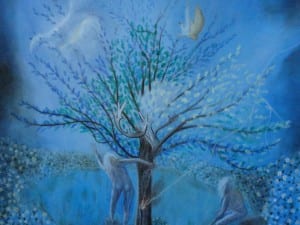With a background in photography, Laureana Toledo’s (b. 1970, Mexico) practice incorporates various media, chosen in relation to a specific concept or theme of the work. Laureana is inspired by the imperceptible or transient moments of the everyday, speculating on how such phenomena can gain new forms of visual presentation. Her work often involves systematic and repetitive interventions into different media (texts, books, photographs etc.) to re-frame their existing narratives.
Her work frequently explores the relationship between different cultures in the UK and Mexico, with a particular example of this being found in her work titled The Limit. Exploring the history of rock music – one of her passions – Laureana formed a Mexican cover-band that borrowed its name from a Sheffield cult rock venue of the eighties. The Limit interpreted songs of popular local bands such as Def Leppard, Pulp and The Human League and toured to Sheffield where they performed to local audiences. This work explored the processes of a local phenomenon ‘gone global’. By taking the music back to Sheffield, Laureana shows how it has acquired new layers of meaning.
Aesthetica spoke to Laureana about her work and her forthcoming projects.
A: What inspires you about the everyday?
LT: Its incongruence, its contradictions and the way things weirdly fall into place.
A: Your work frequently explores cross cultural references between the UK and Mexico. Could you talk us through how these interests play out in your current work?
LT: I think that my work deals with crossovers in general, not specifically betweenMexicoandUK, but also between many other elements, particularly the misunderstandings we have when trying to decipher what we read and cannot fully understand. It also goes the same way when trying to cross something from one artistic discipline to another – the beauty of the debris of the transporting process.
A: This idea of “re-coding narratives” seems to be an important element of your practice. Could you expand on how your work offers alternative readings of pre existing situations or stories?
LT: We are generally told to read reality in so very few ways, but I think reality as an artist is a playground of elements which we can use and recompose to create our own language. It is a way of transforming life into something that we truly want.
A: You’ve just exhibited at PINTA with TJ Boulting. How important do you think these types of fairs are for Latin American artists working today?
LT: Although I don’t like to label my work as just Latin American, I think fairs such as PINTA do provide great opportunities for international artists, particularly in reaching wider audiences. It’s especially important in theUK, where the presence of work originating from Latin American countries is still emerging and finding its place in the market.
A: I think this year was the first that Portuguese artists were represented at PINTA. How significant do you think this is?
LT: It’s great to see both Portuguese and Spanish artists being represented at PINTA this year, as it just goes to show the connection that these countries hold with the Latin American identity. There are some fantastic Portuguese artists out there – I like Paula Rego a lot.
A: What projects are you working on at the moment?
LT: An artist curated show of the photography collection at the Museum of Modern Art in Mexico, an intervention of a space created by Fernando Romero for the central Library in Mexico city, a collaboration with an English composer for Frieze this year and an investigation on railroads and politics in UK and Mexico through the archive of an English engineer.
PINTA: The Modern & Contemporary Latin American Art Show took place at Earls Court Exhibition Centre from 07/06/2012 until 10/06/2012. PINTA travels to New York in November. www.pintaart.com
Credits:
Loreana Toledo, Naive Melody 2 (this must be the place) (2010).
C Type contact print, acrylic paint, 29.7x21cm.
Image courtesy opf TJ Boulting, London.




